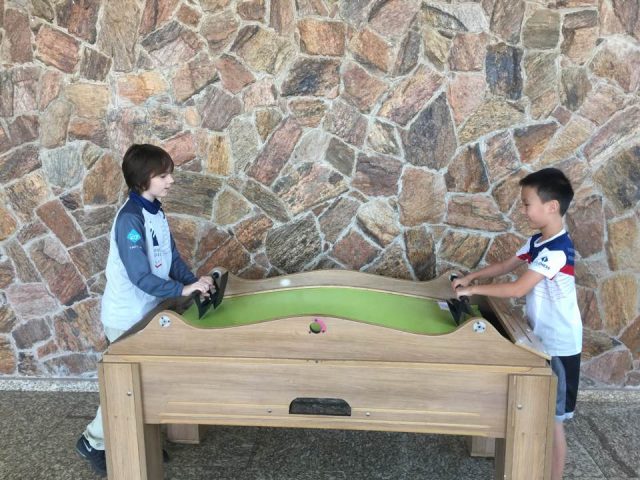 Gus Huston and Christopher Yoo sporting Two Sigma Jackets at the 2017 World Cadet. Yoo started off with a fantastic 5.5/6 and is now in clear first in the Under 12. Huston is also doing well with 4/6.
Gus Huston and Christopher Yoo sporting Two Sigma Jackets at the 2017 World Cadet. Yoo started off with a fantastic 5.5/6 and is now in clear first in the Under 12. Huston is also doing well with 4/6. is
the real winner because she made a close friend. She defeated Brazilian player Stella Correia in the second round, and since then the two have been more or less inseparable. That’s what this tournament is all about!
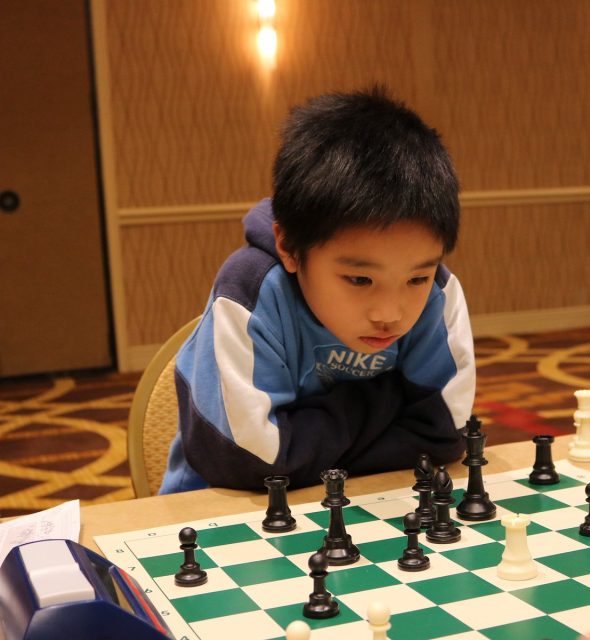 Under 8 Open (click for current results and pairings)
Abhimanyu Mishra became the youngest expert in US Chess history last year and is seeking to become the youngest master. On his path to that title, he hopes to include a gold medal. After the rest day, Mishra sat in clear first with the only perfect score, with Steve Wongso (4.5/5) right behind.
Steve climbed into second place by defeating his fifth-round opponent with the King’s Indian Defense. He misplayed the opening and had a bad knight on b7, but once his opponent erred he unleashed a vicious attack on the kingside. Still, Steve slipped and the topsy-turvy battle continued. In what was one of the most entertaining games of the entire event, the King's Indian action speaks for itself.
Under 8 Open (click for current results and pairings)
Abhimanyu Mishra became the youngest expert in US Chess history last year and is seeking to become the youngest master. On his path to that title, he hopes to include a gold medal. After the rest day, Mishra sat in clear first with the only perfect score, with Steve Wongso (4.5/5) right behind.
Steve climbed into second place by defeating his fifth-round opponent with the King’s Indian Defense. He misplayed the opening and had a bad knight on b7, but once his opponent erred he unleashed a vicious attack on the kingside. Still, Steve slipped and the topsy-turvy battle continued. In what was one of the most entertaining games of the entire event, the King's Indian action speaks for itself.
[pgn]
[Event "World Cadets Chess Championship"]
[Site "?"]
[Date "2017.08.25"]
[Round "5.2"]
[White "Pham, Tran Gia Phuc"]
[Black "Wongso, Steve"]
[Result "0-1"]
[ECO "E94"]
[WhiteElo "1567"]
[BlackElo "1732"]
[Annotator "Hess, R"]
[PlyCount "118"]
[EventDate "2017.??.??"]
1. d4 Nf6 2. c4 g6 3. Nc3 Bg7 4. e4 d6 5. Nf3 O-O 6. Be2 Na6 7. O-O e5 8. d5
Nc5 9. Qc2 a5 10. Be3 b6 11. a3 Bd7 (11... a4 {is possible here, because White
does not win a pawn after} 12. Bxc5 bxc5 13. Nxa4 Nxe4 {with a huge advantage
for Black.}) 12. b4 Nb7 (12... Ncxe4 $1 {is the move that GM Alex Goldin
showed Steve after the game. White has no way to keep the extra piece, and
Black is doing very well.} 13. Nxe4 Nxe4 14. Qxe4 f5 15. Qc2 (15. Qb1 e4 {
is an even worse predicament. If White attempts to obtain two minors for a
rook and a few pawns, the kingside gets steamrolled.} 16. Ne1 f4 17. Bd2 (17.
Bc1 f3 {with a blistering attack.}) 17... e3 18. fxe3 fxe3 19. Bxe3 Qe7) 15...
e4 16. Bg5 Qb8 17. Rae1 exf3 18. Bxf3 {is approximately level, though White
needs to prove equality. The open a-file must be dealt with.}) 13. Nd2 Ne8 14.
Nb3 f5 15. f3 f4 16. Bf2 h5 17. Kh1 g5 18. Qd2 Bh6 19. c5 a4 20. c6 axb3 21.
cxb7 {White takes the wrong piece! That knight on b7 is doing absolutely
nothing, whereas the bishop is always powerful in the KID.} (21. cxd7 Qxd7 {
is strategically winning for White, if he can withstand an attack. This should
be much simpler without the bishop eyeing the h3 square.}) 21... Ra7 22. Qb2
Rxb7 23. Qxb3 g4 24. Qd1 Qg5 25. a4 g3 26. Bg1 Kh8 27. Re1 (27. Bb5 $1 {
was necessary. The move both aims to exchange bishops (which will allow White
to play h3) and opens the second rank for the rook and queen to defend g2.})
27... Rg8 28. Bf1 h4 29. Qd2 (29. h3 Bxh3 {is problematic.}) 29... gxh2 30.
Bxh2 Qh5 (30... Nf6 {with the idea of heading to g3 was powerful as well.}) 31.
Qf2 Bg5 32. a5 (32. Bb5 {again was required. This time it clears the way for
the rook to swing into the defense. At the very least it greatly complicates
the game.} h3 33. Bxd7 Bh4 34. g3 fxg3 35. Qe3 {is crazy!}) 32... h3 {Now it
should be over.} 33. g4 fxg3 34. Bxg3 Rf8 {A very big mistake.} (34... bxa5 35.
bxa5 Rb3 {aims through the knight to f3.} 36. a6 Rxc3 37. a7 Rxf3 {and White
can get another queen, but will be mated in the process:} 38. Qh2 Bh4 39. Bxh4
Qxh4 40. a8=Q Rxf1+ {removes the guard and allows mate along the diagonal.}) (
34... Bd2 {is much safer and picks up at least an exchange, since the bishop
on d2 is immune to capture.}) 35. Be2 {An understandable mistake. When you're
getting attacked your instincts tell you to defend. Here, though, the best
defense was active play.} (35. a6 Rb8 36. Ra3 {the point being that Black
can't capture on f3 and keep the queens on, since} Rxf3 {runs right into} 37.
Be2) 35... Bd2 36. a6 Ra7 37. Rec1 Bxc1 38. Rxc1 Qh6 39. Rc2 (39. Rg1 Nf6 40.
Bh4 {was challenging. It will be difficult for Black to win when faced with
preventing the a-pawn from queening.}) 39... Nf6 40. f4 exf4 41. Bxf4 Qh7 (
41... Qg7) 42. Qd4 (42. Rc1 {with the idea of swinging to g1 was necessary.})
42... Qh4 43. e5 dxe5 44. Bxe5 Qxd4 45. Bxd4 {White is slightly better here.
The king is no longer in danger and it is Black's king that is less safe!} Bf5
46. Rd2 (46. Ra2 {with Nb5 to follow was very strong. Black faces material
loss.}) 46... Kh7 47. d6 Nd7 48. dxc7 (48. Nb5 {was extremely strong here. The
a-pawn was valuable indeed, but a passed pawn on c7 with a rook behind it (and
a knight heading to d6) would have been devastating.}) 48... Rxc7 49. Nb5 Rc1+
50. Kh2 Be4 51. Bg4 (51. Bd1 {kept White safe. Instead, the king was forced
out into the open and}) 51... Rh1+ 52. Kg3 Rg8 53. Nc3 (53. Nd6 {both attacked
the bishop on e4 and prevented it from applying pressure via f5.}) 53... Bf5
54. Nd5 Rxg4+ 55. Kf3 h2 56. Ne3 Rf1+ 57. Nxf1 h1=Q+ 58. Ke3 Qe4+ 59. Kf2 Rg2#
0-1
[/pgn]
Wongso and Mishra squared off in round 6.
[pgn]
[Event "World Cadet Championship"]
[Site "chess24.com"]
[Date "2017.08.27"]
[White "Wongso, Steve"]
[Black "Mishra, Abhimanyu"]
[Result "0-1"]
[WhiteElo "1732"]
[BlackElo "1774"]
[PlyCount "62"]
[EventDate "2017.??.??"]
[WhiteTeam "United States"]
[BlackTeam "United States"]
[WhiteTeamCountry "USA"]
[BlackTeamCountry "USA"]
[WhiteClock "0:59:13"]
[BlackClock "0:29:50"]
1. e4 c5 2. Nf3 e6 3. d4 cxd4 4. Nxd4 Nc6 5. Nc3 Qc7 6. g3 a6 7. Bg2 Nf6 8. O-O
Be7 9. Be3 O-O 10. a4 d6 11. f4 Re8 12. g4 Nxd4 13. Bxd4 e5 14. fxe5 dxe5 15.
Be3 Bxg4 16. Qe1 Be6 17. h3 Nh5 18. Qf2 Rac8 19. Kh2 Bc5 20. Bxc5 Qxc5 21. Qh4
Nf4 22. Rf3 Qe7 23. Qg3 Red8 24. Rg1 Rd2 25. Rf2 Rxf2 26. Qxf2 Qb4 27. Rb1 Rxc3
28. Qd2 Rxh3+ 29. Bxh3 Qxd2+ 30. Kg1 Bxh3 31. Rd1 Qg2# 0-1
[/pgn]
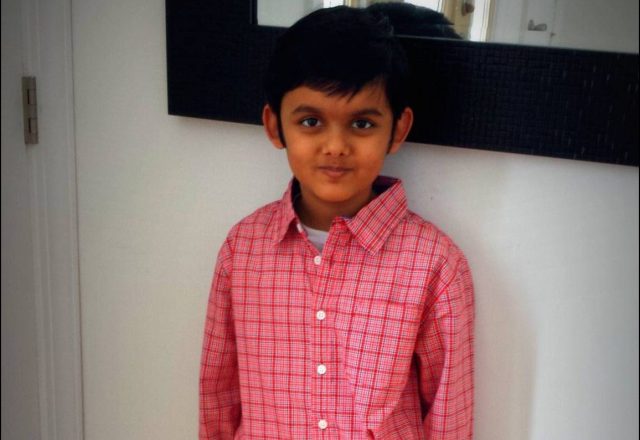 Abhimanyu Mishra, now on 6/6.
Abhimanyu Mishra, now on 6/6.
Ellen went on to win on Sunday to move her score up to 5/6:
[pgn]
[Event "World Cadet Championship"]
[Site "chess24.com"]
[Date "2017.08.27"]
[White "Wang, Ellen"]
[Black "Nguyen, Le Cam Hien"]
[Result "1-0"]
[WhiteElo "1624"]
[BlackElo "1394"]
[PlyCount "75"]
[EventDate "2017.??.??"]
[WhiteTeam "United States"]
[BlackTeam "Vietnam"]
[WhiteTeamCountry "USA"]
[BlackTeamCountry "VIE"]
[WhiteClock "0:11:55"]
[BlackClock "0:16:23"]
1. e4 c5 2. Nf3 d6 3. d4 cxd4 4. Nxd4 Nf6 5. Nc3 g6 6. Bc4 Bg7 7. O-O O-O 8.
Re1 Nc6 9. Bg5 Bd7 10. Bb3 h6 11. Bh4 Rc8 12. Qd2 Kh7 13. Rad1 a6 14. Nxc6 Bxc6
15. Nd5 g5 16. Bg3 Nxd5 17. exd5 Bd7 18. c3 Bf5 19. h4 Bf6 20. Bc2 Bxc2 21.
Qxc2+ Kg7 22. Qe4 Rh8 23. h5 b5 24. a3 a5 25. Re2 Qb6 26. a4 Rc4 27. Qc2 b4 28.
Qd3 Rhc8 29. cxb4 Rxb4 30. Qf5 Rc7 31. Re6 Bxb2 32. Rxh6 Bf6 33. Qh7+ Kf8 34.
Rxf6 Ke8 35. Qxf7+ Kd8 36. Qg8+ Kd7 37. Qe6+ Ke8 38. Rg6 1-0
[/pgn]
The highest rated player in the section is Hungary’s Zsoka Gaal, who boasts an impressive 1956 FIDE and actually has gained another 100 points. Zsoka tied for first (silver on tiebreaks) in the Under 8 Girls in 2015, so she has both strength and experience. However, upsets are commonplace in world youth events, as evidenced by Shivika Rohilla’s 4.5/5 score despite having a pre-tournament rating of just 1251. In fact, Shivika already drew Zsoka, further indicating that the kids should ignore their opponent’s rating.
Interestingly, the top seven places are occupied by players from seven different countries. The standings exhibit the “world” in World Cadets.
Under 10 Open
Looking at the leaderboard of this event, it would appear that few non-Americans were playing in it. An absurd 10 of the top 19 places are occupied by American players.
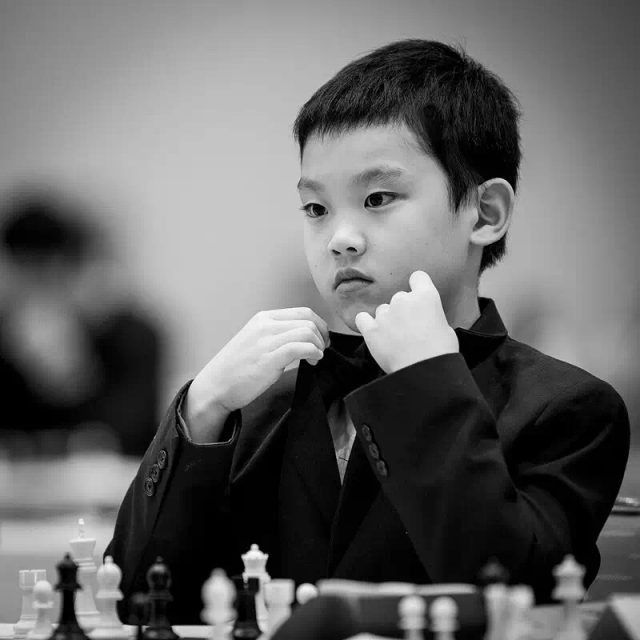 Liran Zhou. Photo courtesy of the Zhou family
Liran Zhou. Photo courtesy of the Zhou family[pgn]
[Event "World Cadet Championship"]
[Site "chess24.com"]
[Date "2017.08.27"]
[White "Zhou, Liran"]
[Black "Xu, Arthur Zihan"]
[Result "1-0"]
[WhiteElo "1897"]
[BlackElo "1903"]
[PlyCount "155"]
[EventDate "2017.??.??"]
[WhiteTeam "United States"]
[BlackTeam "United States"]
[WhiteTeamCountry "USA"]
[BlackTeamCountry "USA"]
[WhiteClock "1:26:49"]
[BlackClock "0:17:55"]
1. e4 c5 2. Nf3 d6 3. d4 cxd4 4. Nxd4 Nf6 5. Nc3 a6 6. Bc4 e6 7. O-O b5 8. Bb3
Be7 9. Qf3 Bb7 10. Bxe6 fxe6 11. Nxe6 Qd7 12. Nxg7+ Kf7 13. Nf5 Nc6 14. Nd5 Ne5
15. Qg3 Ng6 16. Ndxe7 Nxe4 17. Qb3+ d5 18. Nxg6 hxg6 19. Ng3 Nf6 20. Bg5 Ng4
21. Qf3+ Kg8 22. h3 Ne5 23. Qf6 Qg7 24. Qe6+ Kh7 25. Bf6 Rhe8 26. Qd6 Nc4 27.
Qf4 Rf8 28. Qh4+ Qh6 29. Qxh6+ Kxh6 30. Bd4 Rfe8 31. Rfe1 Kh7 32. Nf1 Bc6 33.
Nh2 Rxe1+ 34. Rxe1 Re8 35. Rxe8 Bxe8 36. Ng4 Bf7 37. Kf1 Nd6 38. Ke2 Be6 39.
Ne5 Nf5 40. Kd3 Kh6 41. c3 Nd6 42. Nc6 Kg5 43. f4+ Kh6 44. g4 Kh7 45. Be3 Kg7
46. Kd4 Nc4 47. b3 Nb6 48. Ke5 Bd7 49. Nb8 Nc8 50. Nxd7 Ne7 51. Bc5 Kf7 52.
Bxe7 Kxe7 53. Nc5 a5 54. Kxd5 b4 55. cxb4 axb4 56. Nd3 Kf6 57. Nxb4 g5 58. f5
Kg7 59. Ke6 Kf8 60. Kf6 Kg8 61. Kxg5 Kf7 62. Nd5 Ke8 63. f6 Kf8 64. Kg6 Kg8 65.
f7+ Kf8 66. Nf4 Ke7 67. Kg7 Kd6 68. f8=Q+ Ke5 69. h4 Ke4 70. h5 Kf3 71. h6 Kf2
72. h7 Kg1 73. h8=Q Kf2 74. Qh3 Ke1 75. Qe3+ Kd1 76. Qe2+ Kc1 77. Qa3+ Kb1 78.
Qd1# 1-0
[/pgn]
Amazingly, many of the other Americans avoided playing one another on Sunday. Lucas Foerster-Yialamas (4.0/5), whose birthday we celebrated at the team dinner sponsored by Two Sigma, played on board three in round six. Frank Prestia (4.0) wa
s on board four, Vyom Vidyarthi (4.0) on five, Jack Levine (3.5) on six, and it isn’t until board seven that we see two American flags, with Luke Ye facing Adrian Kondakov.
Tejas Rama and Adi Murgescu are in contention just like the aforementioned octet.
All eyes have been on India’s Bharath Subramaniyam, who outrates the French quartet seeded after him by over 240 points. Bharath won the World Cadet under 8 in 2015 and is currently rated over 2200 FIDE.
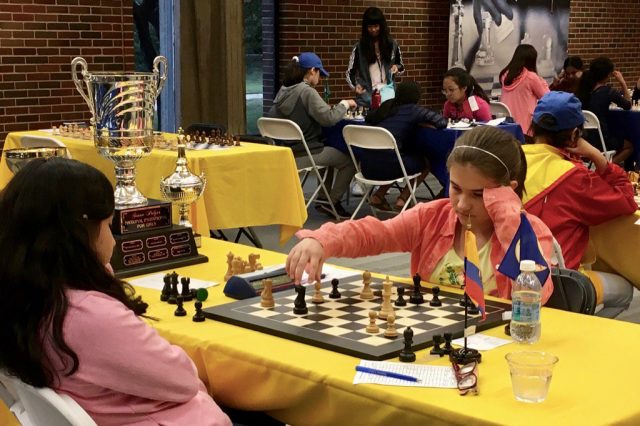 Matus at the Susan Polgar Foundation Invitational
Matus at the Susan Polgar Foundation Invitational
[Event "World Cadets Chess Championship"]
[Site "?"]
[Date "2017.08.23"]
[Round "3.3"]
[White "Matus, Nastassja A"]
[Black "Cai, Boheng"]
[Result "1-0"]
[ECO "E11"]
[WhiteElo "1910"]
[BlackElo "1710"]
[Annotator "Hess, R"]
[PlyCount "121"]
[EventDate "2017.??.??"]
1. d4 Nf6 2. c4 e6 3. g3 Bb4+ 4. Bd2 Qe7 5. Nf3 Nc6 6. Nc3 d6 7. Bg2 Bxc3 8.
Bxc3 Ne4 9. Rc1 O-O 10. d5 Nxc3 11. Rxc3 Nb8 12. dxe6 fxe6 13. O-O Nd7 14. Qc2
e5 15. Nd2 Nf6 16. Ne4 Kh8 17. Nxf6 Qxf6 18. Rf3 Qe7 19. Rxf8+ Qxf8 20. Rd1 Bf5
21. Qd2 Rb8 22. Qa5 Qc8 23. Qxa7 Ra8 24. Qxb7 Qxb7 25. Bxb7 Rxa2 26. Rd2 Ra7
27. Bd5 Bh3 28. f3 h5 29. Be4 Kg8 30. Bg6 Kf8 31. Bxh5 Ra1+ 32. Kf2 Rf1+ 33.
Ke3 Bf5 34. Bg4 Bg6 35. Be6 Ke7 36. Bd5 Kd7 37. c5 Rh1 38. cxd6 cxd6 39. h4 Rc1
40. g4 Rc5 41. Be4 Bf7 42. Rc2 Ra5 43. Bf5+ Ke7 44. Kf2 g6 45. Rc7+ Ke8 46. Bd3
d5 47. b4 Ra8 48. Bb5+ Kf8 49. Bc6 Rb8 50. b5 Be6 51. Ra7 d4 52. Ra8 Rxa8 53.
Bxa8 Ke7 54. Bc6 Bf7 55. b6 Kd6 56. b7 Kc7 57. Ke1 Bc4 58. Be8 Kxb7 59. Bxg6
Kc7 60. h5 Bg8 61. h6 1-0
[/pgn]
In a relatively small tournament like this one, players have an opportunity to make up ground. Unfortunately for the Americans in this section, Ambica Yellamraju and Aksithi Eswaran (3.5/5) play each other, while Rianne Ke and Annapoorni Meiyappan (3.0/5) must do the same. Any decisive game will catapult the victor into medal contention.
It certainly is worth mentioning that Ambica’s twin sister Aparna is also competing!
Under 12 Open
Five of the top ten rated players in this section are from the United States, so it’s no surprise to see so many Americans at the top of the standings.
Christopher Yoo, who held the record for youngest U.S. master prior to Liran Zhou, is a very talented 2242 FIDE and has escaped tough positions in a few of his games. As the highest rated player with 4.5 points, he floated up to play undefeated IM-elect Javokhir Sindarov. He won an exciting game against Sindarov- he lost his queen on move 28 but his two pieces and d-pawn proved powerful compensation.
[pgn]
[Event "World Cadet Championship"]
[Site "chess24.com"]
[Date "2017.08.27"]
[White "Yoo, Christopher Woojin"]
[Black "Sindarov, Javokhir"]
[Result "1-0"]
[WhiteElo "2242"]
[BlackElo "2399"]
[PlyCount "83"]
[EventDate "2017.??.??"]
[WhiteTeam "United States"]
[BlackTeam "Uzbekistan"]
[WhiteTeamCountry "USA"]
[BlackTeamCountry "UZB"]
[WhiteClock "0:29:18"]
[BlackClock "0:47:54"]
1. e4 e5 2. Nf3 Nc6 3. Bb5 a6 4. Ba4 g6 5. d4 exd4 6. c3 Bg7 7. cxd4 b5 8. Bb3
d6 9. Ng5 Nh6 10. Bd5 Bd7 11. Be3 O-O 12. h3 Rc8 13. Nf3 Ne7 14. Bb3 d5 15.
exd5 Nhf5 16. Bf4 b4 17. g4 Nd6 18. O-O Bb5 19. Re1 c6 20. Bg5 f6 21. dxc6+ Kh8
22. Bf4 Bxc6 23. d5 Bb7 24. Nd4 Nc4 25. Bxc4 Rxc4 26. d6 Nd5 27. Ne6 Qc8 28.
Bg3 Ne3 29. Rxe3 Qc6 30. f3 Rc1 31. Nd2 Rxd1+ 32. Rxd1 Bh6 33. g5 Bxg5 34. Nxg5
Qc5 35. Nf1 fxg5 36. d7 Rd8 37. Be5+ Kg8 38. Bf6 Ra8 39. d8=Q+ Rxd8 40. Rxd8+
Kf7 41. Be7 Qb5 42. Bd6 1-0
[/pgn]
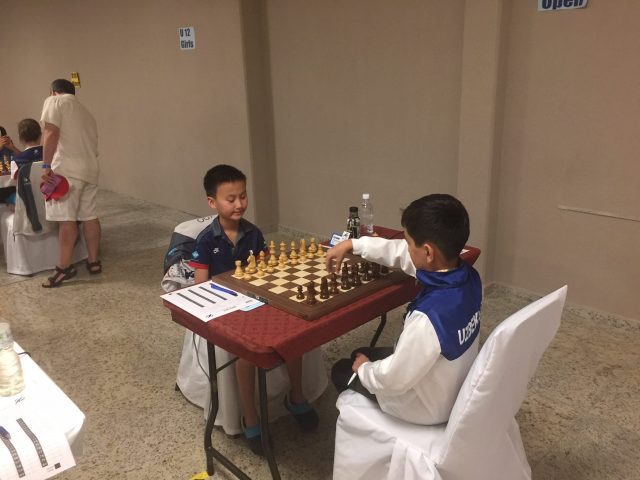 Yoo vs. Sindarov
Yoo vs. Sindarov who lost on board two in round six to Gazorig Amartuvshin, but
seems to be underrated at 1884 FIDE. He earned his 4.5 points by drawing a 2282 and defeating a 2126 (Maximillian Lu, another former record holder for youngest American master) and a 2281 (Anthony He from the USA).
Gus Huston and Vincent Tsay both came out of the rest day with 4/5
, so they are in striking distance too.
There is too much chaos to handle in this event, with 14 Americans on the top 15 boards. Of course that means that friends will be paired, but it also bodes well for medal chances. For instance, Gus will play his fourth American opponent in round six.
One final note I’ll add is that it is very important to me to see more girls gaining access to chess. While I am happy to see that progress has certainly been made, there remains a noticeable disparity: there are 253 players in the open sections compared to 166 in the girls sections.
Follow results and pairings at chessresults.com and live games on the top boards at chess24. Find out more about sponsor Two Sigma here.
 Gus Huston and Christopher Yoo sporting Two Sigma Jackets at the 2017 World Cadet. Yoo started off with a fantastic 5.5/6 and is now in clear first in the Under 12. Huston is also doing well with 4/6.
Gus Huston and Christopher Yoo sporting Two Sigma Jackets at the 2017 World Cadet. Yoo started off with a fantastic 5.5/6 and is now in clear first in the Under 12. Huston is also doing well with 4/6.  Under 8 Open (click for current results and pairings)
Abhimanyu Mishra became the youngest expert in US Chess history last year and is seeking to become the youngest master. On his path to that title, he hopes to include a gold medal. After the rest day, Mishra sat in clear first with the only perfect score, with Steve Wongso (4.5/5) right behind.
Steve climbed into second place by defeating his fifth-round opponent with the King’s Indian Defense. He misplayed the opening and had a bad knight on b7, but once his opponent erred he unleashed a vicious attack on the kingside. Still, Steve slipped and the topsy-turvy battle continued. In what was one of the most entertaining games of the entire event, the King's Indian action speaks for itself.
Under 8 Open (click for current results and pairings)
Abhimanyu Mishra became the youngest expert in US Chess history last year and is seeking to become the youngest master. On his path to that title, he hopes to include a gold medal. After the rest day, Mishra sat in clear first with the only perfect score, with Steve Wongso (4.5/5) right behind.
Steve climbed into second place by defeating his fifth-round opponent with the King’s Indian Defense. He misplayed the opening and had a bad knight on b7, but once his opponent erred he unleashed a vicious attack on the kingside. Still, Steve slipped and the topsy-turvy battle continued. In what was one of the most entertaining games of the entire event, the King's Indian action speaks for itself.











